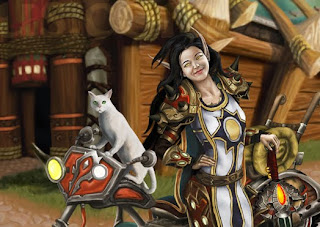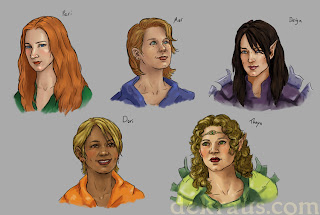Take yogurt for example. Bought in a tub in the supermarket, this thick dairy stuff is kind of a mystery. It's just milk and cultures. That's all it is. Heat some milk, put in some cultures, let it sit... there's yogurt! Granted, there are some times and temperatures to watch, but the basics are pretty simple. Or, I should say, understanding yogurt is pretty simple.
I recently watched an interview with a successful concept artist, Anthony Jones. Near the end of the interview he talked about how important it is to understand all the various facets of creating art - to understand light and composition and perspective and color. I realized that's the same tack I've been on since classes have ended; I've poked and prodded at some things, looked at them upside down, and said, "I want to understand this." It's not enough to know how to follow my eyes and copy a picture. I want to know how to turn the subject around in my head and draw it every which way. I want to understand the human figure the same way I understand yogurt.
The figure is what I started with, as it's so essential to any scene involving humanity. Despite being good at copying models, I don't understand the figure the way I want to. So I struck out searching for ways to do so, lacking sitting in a room with a real live model before me. I've gone through Loomis' basic structures and started working through Vanderpoel's studies. I read books online about drawing comic-style and anime. I searched Google and came upon a little site tucked away that had an excellent page about drawing the figure but was mostly about color theory. It was the color theory, a tangent to my own quest, that really got me thinking.
Whether you're an artist or not, I beg you to go to this page on the Real Color Wheel and take a moment to scroll down. You don't have to read it. Just look at the charts, the manipulations, the experiments, the lengthy explanations. This is an artist trying to understand color. The color wheel isn't just a spectrum laid out in a circle. The importance of it runs across the circle, in matching complementary pairs in order to bring those colors down to darks without using black. Complementary pairs "mute" each other, taking away brilliance and saturation. This is incredibly important when painting shadows.
Many of us grew up being taught that Red, Yellow, and Blue are the primary colors, and Orange, Green and Violet the secondary. In that color wheel, Red is opposed by Green, Yellow by Violet and Blue by Orange. But what if that's not entirely correct? One artist works his way through his palette and natural sources and says, no, wait, Red is opposed by Cyan (a blue-green) and Yellow by BLUE. What difference does this make? Darks mixed by Red and Green are brownish. Darks mixed from Red and Cyan are cool gray. That's a big difference, when shadows in warm light are meant to be cool.
The puzzle of understanding color in the real world. The puzzle of understanding all the complexities of the human form. The puzzle of taking the three-dimensional world around us and attempting to portray it on two dimensions. These are the puzzles artists have struggled with since they first drew a stick-bison on a cave wall with a bit of burnt stick.
People love to talk about art in terms of "passion" and "talent" and so many other ideals that are hard to quantify. No doubt it takes a certain amount of passion to be dedicated to any pursuit, and no doubt there are natural inclinations - especially those dealing with spacial understanding and a visual mind - that certainly help any artist. But just like doctors must understand human physiology and engineers must understand physics and thermodynamics, there's a wealth of information and ideas artists must understand as well. And because Art isn't considered a science, a lot of it is floating around in the ether between artists, some taught here, some taught there, information fading in and out through the centuries as we learn and relearn again, peering through the world around us to try to understand these things in order to share them with each other through our creations.
I've made a mental list lately of the things I don't quite understand, but need to in order to create the artwork I wish to create. Top of the list, of course, is the human figure. There's a lot I'd like to work with regarding color, too. Composition, something I've never felt good about, also has a pretty prominent place.
Right above making a perfect loaf of whole-wheat bread.


